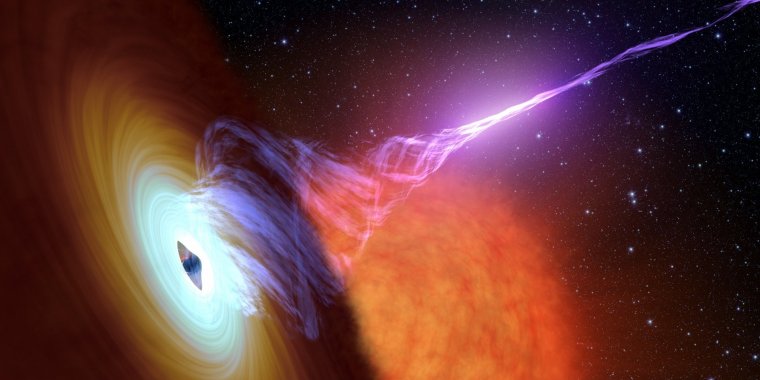| News / Science News |
NuSTAR Probes Black Hole Jet Mystery
Black holes are famous for being ravenous eaters, but they do not eat everything that falls toward them. A small portion of material gets shot back out in powerful jets of hot gas, called plasma, that can wreak havoc on their surroundings. Along the way, this plasma somehow gets energized enough to strongly radiate light, forming two bright columns along the black hole’s axis of rotation. Scientists have long debated where and how this happens in the jet.

This artist’s concept shows a black hole with an accretion disk -- a flat structure of material orbiting the black hole – and a jet of hot gas, called plasma. ![]()
Using NASA's NuSTAR space telescope and a fast camera called ULTRACAM on the William Herschel Observatory in La Palma, Spain, scientists have been able to measure the distance that particles in jets travel before they "turn on" and become bright sources of light. This distance is called the "acceleration zone."
Scientists looked at two systems in the Milky Way called "X-ray binaries," each consisting of a black hole feeding off of a normal star. They studied these systems at different points during periods of outburst -- which is when the accretion disk -- a flat structure of material orbiting the black hole -- brightens because of material falling in.
One system, V404 Cygni, had reached nearly peak brightness when scientists observed it in June 2015. At that time, it experienced the brightest outburst from an X-ray binary seen in the 21st century.
The other, GX 339-4, was less than 1 percent of its maximum expected brightness when it was observed. The star and black hole of GX 339-4 are much closer together than in the V404 Cygni.
The systems showed similar time delays – about one-tenth of a second -- between when NuSTAR first detected X-ray light and ULTRACAM detected flares in visible light slightly later.
The X-ray light originates from material very close to the black hole. Strong magnetic fields propel some of this material to high speeds along the jet. This results in particles colliding near light-speed, energizing the plasma until it begins to emit the stream of optical radiation.
Where in the jet does this occur? The measured delay between optical and X-ray light explains this. By multiplying this amount of time by the speed of the particles, which is nearly the speed of light, scientists determine the maximum distance traveled.
This expanse of about 19,000 miles (30,000 kilometers) represents the inner acceleration zone in the jet, where plasma feels the strongest acceleration and "turns on" by emitting light. That's just under three times the diameter of Earth, but tiny in cosmic terms, especially considering the black hole in V404 Cygni weighs as much as 3 million Earths put together.
In one supermassive system called BL Lacertae, weighing 200 million times the mass of our Sun, scientists have inferred time delays millions of times greater than what this study found. That means the size of the acceleration area of the jets is likely related to the mass of the black hole. (NASA)
YOU MAY ALSO LIKE




